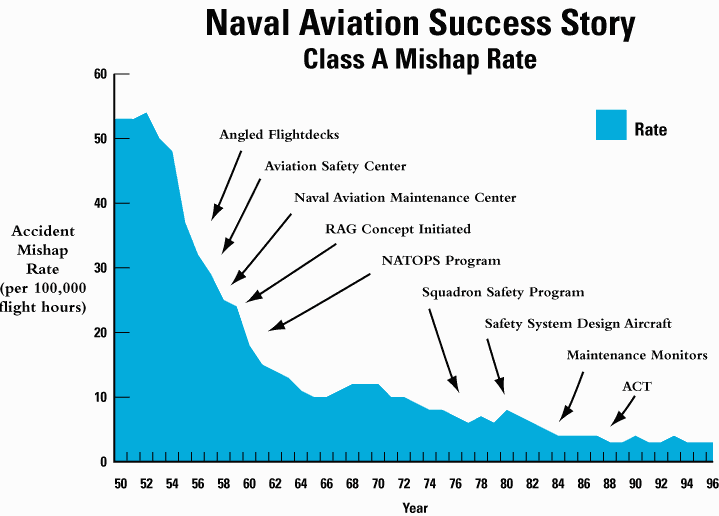SAFETY
Balance is also achieved by a consistent emphasis on safety. We have
made impressive progress in aviation safety since the 1950s, but in the
last few years we have reached a plateau. The incalculable cost of the
loss of a shipmate and the staggering cost of the destruction of hardware
demand a fresh approach to reducing the mishap rate. Ultimately, our goal
is to continue to drive mishap rates toward zero while preserving, or even
enhancing, our warfighting readiness.
The tenets of our safety policy include:
-
New and remanufactured aircraft shall be equipped with Flight Data Recorders
(FDRs), Cockpit Voice Recorders, Condition-Monitoring Systems, Ground Proximity
Warning Systems, and Collision Avoidance Systems.
-
Passenger aircraft (including rotary-wing and troop-carrying aircraft)
and large aircraft shall be refitted with commercial-standard systems for
comparable aircraft.
-
All other aircraft shall be equipped with subject systems when justified
by cost-benefit analysis.

There are several systems that will allow us to improve Naval Aviation
safety.
-
Condition-monitoring systems are a recent introduction of common industrial
vibration-monitoring techniques and equipment into aviation. Integrated
Mechanical Diagnostics (IMD) provides significant, early information about
anomalies in the drive train (including the engines) and monitors rotor
systems for tracking and balancing. IMD is a safety-of flight system because
of its ability to predict a failure before it occurs.
-
Based on the past 10 years of statistics, controlled flight into terrain,
including water, has been a primary cause of fatal mishaps. The introduction
of the Ground Proximity Warning System into many naval aircraft, especially
tactical aircraft and helicopters, is predicted to have a payback of 50
percent or higher in the first year.
-
Flight Data Recorders are windows on human performance ‹ they monitor more
than 80 percent of potential accident-causing factors. "Glass cockpits"
have presented new challenges to aircraft crash investigators by reducing
the amount of hard evidence that can be found at a crash site. FDRs are
needed to provide information that cannot be provided any other way.
-
The number of near mid-air collisions involving naval aircraft has increased
significantly during the past few years. Collision avoidance systems are
critical safety-of-flight systems that allow aircraft to "see" aircraft
around them and maintain their separation.





